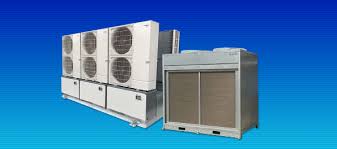Water Less Cooling Towers:
Water less cooling tower is easy to see how the variability in makeup waters quality and the complexity of managing tower and related businesses. Water less cooling towers are typically the largest user of potable water in commercial, institutional and industrial buildings, often accounting for 15% to 30% of total water consumption. Office buildings are at the top of the cooling water use list, followed by manufacturing, education, hospitals and lodging.
Image:

Process:
Water less cooling towers are water flow rates below the design point will not produce a full spray pattern and void areas will start to appear. Any fill’s best efficiency is achieved when the liquid-to-gas ratio is evenly balanced throughout the fill media. Short patterns and overlapping patterns cannot accomplish it. When a cooling tower system is faced with a variable water flow rate (i.e. multiple pump cycling or variable speed pumping) these pattern problems force the operator to isolate whole cooling tower cells to maintain proper water distribution under reduced load in the remaining on-line cells. If this is not done, the tower efficiency will suffer and the fill media will quickly foul. Isolating cells takes away air-to-water contact surface. A water distribution system that can respond to variable flow rates and keep all of the fill media evenly wetted and in service is needed. This requires a nozzle that responds to flow changes to keep a constant pattern. A square pattern that avoids overlap would be best.
Advantages:
- Low maintenance costs
- Ozone is produced on-site and requires no storage of dangerous chemicals
- Ozone requires no additional disinfectants
- No cocktail of disinfectants necessary. Micro-organism cannot get resistant to ozone after prolonged use of ozone
- High efficiency as disinfectant. A residual ozone concentration of 0.1 to 0.2 ppm is in most cases very effective in keeping the cooling tower and the cooling circuit clean.
- Very effective in removing bio films·
- Higher efficiency of heat exchangers due to reduced bio film formation
- Due to good bio film removal capacities very effective against Legionella
- No chlorinated compounds. Very low corrosion rates in the system.
- No persistent chemicals or disinfectants in bleed. Ozone breaks down to oxygen.
- In some cases ozone can replace disinfectants and also dispergents and inhibitors
- In many cases a higher concentration factor is possible
- Lower operational costs and in many cases a lower overall costs
- Ozone is effective in a wide pH range
- Also effective for mussel growth
- In the design of proper ozone disinfected cooling tower, one needs to take care of the following points
- Supple ion water with high hardness and / or high COD levels is less suitable for ozone based cooling towers
- Retention time in the system. The half time of ozone is normally less than 10 minutes in cooling systems. to assure an adequate residual ozone concentration it is necessary to start with an adequate begin concentration.
- Dead spots. Because ozone depletes to oxygen, spots with little circulation have to be prevented.
- Temperature. The solubility of ozone and the half life time of ozone decreases at higher temperatures. This limits the temperature of the cooling water in which ozone can be used. This limit is in most cases around the 45°C.
- Material. The materials used in the cooling tower need to be ozone resistant.
- If there are any questions, please contact us.
Benefits:
- Return on investment usually less than two years
- Water conservation of > 1000 gal/day/100 tons of cooling capacity
- Up to 10% heat transfer and condenser efficiency improvement
- Environmentally and ecologically the safes treatment available.

